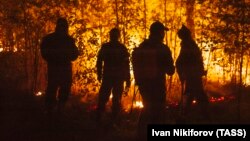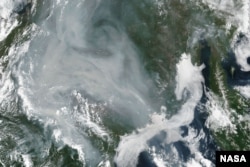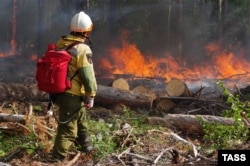Bone-chilling winter temperatures. Sub-Arctic taiga forests as far as the eye can see. Blinding clouds of mosquitos. Vast deposits of diamonds, gold, and other minerals.
Add to the list of qualities for the vast Siberian region known as Yakutia: home to the world’s largest wildfires this year.
In the United States, the largest blaze wreaking havoc this season is in California, the so-called Dixie Fire, and is currently burning nearly 3,000 square kilometers -- about the size of Luxembourg.
In Yakutia, the total area of the fires scorching the taiga this season are 10 times that.
But there's more: according to the environmental group Greenpeace on August 16, more than 170,000 square kilometers have burned across Russia this year -- making the 2021 fires the worst in a decade, and possibly ever. That's an area about the size of the U.S. state of Florida.
And the fire season still has weeks to go.
How Big Are They?
As of this writing, there are nearly 300 wildfires reportedly burning across Russia; the worst -- in terms of area and population affected -- are in Yakutia, a region roughly the size of Argentina.
With about 40 percent of its territory located above the Arctic Circle, the region, officially known as the Sakha Republic, is known for wide swings in seasonal temperatures, from body-numbing winter cold to oppressive summer heat.
Much of the territory is covered with dense taiga: heavy, wet coniferous forests interspersed with boggy permafrost whose warming temperatures pose a distinct threat of their own (more on that later). Home to giant mosquitos, the forests are vast and largely uninhabited -- and prone to burning during the annual fire season.
This year is different.
As of August 24, according to the regional Emergency Situations Ministry, around 1,300 square kilometers were currently burning.
That’s an improvement by about half from early July, when a blanket of smoke prompted officials to advise the roughly 300,000 residents of the regional capital, Yakutsk, to place damp towels around windows and doors to minimize smoke seeping in and to wear masks when walking outdoors.
Some 3,800 kilometers to the west, near the Ural Mountain city of Yekaterinburg, a fire sent plumes of smokes and flames soaring over a major highway, halting traffic.
Fires have also been raging in the northwestern region of Karelia, across the central Volga region, and elsewhere.
The smoke from the Yakutia fires was so extensive that researchers recorded -- for the first time ever -- smoke reaching as far as the North Pole.
Is This About Climate Change?
Yes.
Northern Siberia has seen unusually high summer temperatures over the past couple years.
2020 was particularly brutal, with temperatures showing monthly averages more than 10 degrees Celsius above the average for the 29-year period from 1981–2010. That June, the Arctic Circle town of Verkhoyansk, about 675 kilometers north of Yakutsk, reported the highest-ever temperature recorded in the Arctic: 38.2 degrees Celsius.
In a report released this month on changing climate worldwide, the American Meteorological Society said the increased Arctic and Siberian temperatures in 2020 were “very large positive temperature anomalies.”
“In eastern Siberia, a widespread dry anomaly was observed in the region that experienced massive wildfires and a record heat wave,” the report said.
A multinational group of scientists concluded, in an article published in June in the journal Climate Change, that the prolonged heat in Siberia would have been almost impossible without human-induced climate change.
That conclusion, and its effects on this year’s fires in Yakutia, was endorsed by Sakha Republic head Aisen Nikolayev.
The region faced "the driest and hottest summer since the late 19th century," he said in a televised interview on July 21.
“The word 'unprecedented' is often used this year, mainly in connection with the recent report on climate change,” Grigory Kuksin, head of the wildfires section of the Russian branch of Greenpeace, said in a statement. “Of course, fires and climate are interrelated things. The unprecedented areas of fire are partly the result of climate change, and partly the fires themselves are driving climate change."
What Does The Kremlin Say?
For years, the Kremlin has downplayed the findings of climate science and the looming dangers of climate change.
In 2018, at an international business forum in Moscow, Russian President Vladimir Putin questioned the science behind human-induced climate change. He suggested instead it might be explained by “changes of global character, cosmic changes, some invisible moves in the galaxy.”
In addition, the Kremlin has made it a point of playing up the possible positive impact on, in particular, Russia’s once ice-bound Arctic regions. Melting ice means more access to shipping lanes and makes it easier to search for oil, gas, and other minerals, on land and on the seafloor.
Some officials have also predicted that as forests retreat northward in the face of a shifting climate and permafrost becomes arable land, the country’s agricultural output could increase.
Still, Putin's rhetoric has begun to shift.
At a video conference last month with top officials, Putin specifically focused on the growing number of natural disasters Russia has seen this year.
"All this is largely connected to climate change -- both global and in our country," he was quoted as saying.
A week later, he highlighted the Siberian wildfires, calling them “unprecedented." He also focused on unusual flooding that has affected a swath of southern Siberia, even briefly closing a bridge crossed by the Trans-Siberian Railway.
Russian officials have also begun warning of the dangers to Arctic infrastructure as the permafrost melts, including the risk of oil pipelines rupturing or apartment buildings cracking as their foundations sink.
During this year’s annual Direct Line call-in show, when average Russians are able to ask ostensibly uncensored questions of Putin, the Russian president gave one of his clearest statements to date about climate change science.
“This is one of the most urgent and most debated topics related to climate change and global warming,” he said. “Many believe, with good reason, that it is connected primarily to human activity, to emissions of pollutants into the atmosphere, mostly carbon dioxide.”
“It may be right or wrong, but we must certainly do our best to minimize our contribution to the developments in the global sphere, including in the universe in general,” he said.
Russia in 2019 signed the Paris Climate accord, but experts have said Moscow's goal of reducing greenhouse-gas emissions to 30 percent of 1990 levels by 2030 was "critically insufficient."
On the question of wildfires, there are more immediate steps the Kremlin, and local governments, should take, environmental groups say. That includes revisiting what many have called the disastrous decision to disband the federal aviation network for spotting fires and to shift its planes and other assets to regional authorities instead.
“It is necessary to take measures to strengthen forest protection, develop the movement of voluntary forest firefighters, eliminate the practice associated with burning from agriculture and forestry, develop a system of reliable accounting of all types of fires, significantly ease the bureaucratic burden on foresters, which takes time from the real work in the forest and firefighting,” Greenpeace said.
Wait. It Gets Worse?
Some reports have estimated that the Yakutia fires may have already released nearly 800 million metric tons of carbon dioxide into the atmosphere.
The risks of bigger, hotter, wilder wildfires -- and more frequent droughts or floods -- are the most tangible dangers forecast for Russia if the global climate continues to heat unabated.
There’s also a potential significant tipping point if permafrost warms quickly and widely.
According to a report by the Intergovernmental Panel on Climate Change, the United Nations organization for assessing the science related to climate change, permafrost in Russia and other Arctic regions could stop freezing altogether by 2050, resulting in a major release of carbon and methane “with the potential to exacerbate climate change.”
While carbon dioxide is a problem, methane is far more potent and worrisome to scientists.
The European Commission climate monitoring agency, the Copernicus Atmosphere Monitoring Service, estimated that in 2020, a record 540 million metric tons of carbon dioxide was released by the fires across Siberia and other Arctic regions.
And the idea that a warming climate will be an unequivocal boost for Russian agriculture, with more arable land available for farming?
The flipside of that could be more frequent and more damaging droughts in Russia’s traditional breadbasket regions that could reduce harvests for staple grains like wheat and corn. And crop-damaging pests will become an increasingly serious problem in regions where forests are retreating and farmers clear land for planting.




